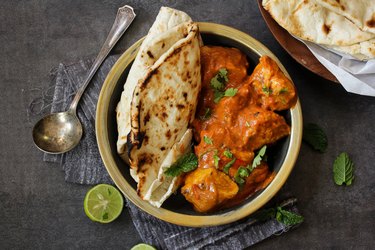
Indian cuisine is meant to provide the diner a spectrum of flavors, with its recipes often including a multitude of spices. Butter chicken, also known as murgh makhani, is a spicy, creamy tomato Indian dish flavored with a variety of seasonings that may include chili powder, garlic, garam masala, ginger, coriander and fenugreek.
This decadent dish also features cream and butter, and knowing its nutrition information can help you make adjustments to your diet to fit it in. Here's a basic breakdown of a four- to five-ounce serving:
Video of the Day
Video of the Day
- Calories: 438
- Fat: 28 grams
- Carbohydrates: 14 grams
- Protein: 30 grams
Butter Chicken Calories
Nutrition information can vary depending on your recipe and serving size. On average, one serving consisting of one boneless chicken breast with sauce, about 4 to 5 ounces, may contain 438 calories.
Be sure to balance your daily calorie intake to maintain your weight. Most healthy, moderately active adults — engaging in regular physical activity equivalent to walking 1.5 to 3 miles a day — can maintain their weight consuming 1,800 to 2,800 calories a day.
Read more: 10 Ways to Eat Healthy at Indian Restaurants
Fat Content and Considerations
Butter chicken contains butter, and sometimes cream, making it a high-fat meal choice. Depending on your recipe, one serving of butter chicken may contain about 28 grams of total fat, 12 grams of saturated fat.
Both butter and cream are high in saturated fat. High intakes of saturated fat increase blood cholesterol levels and risk of heart disease. Keep your daily saturated fat intake to less than 10 percent of calories, or about 22 grams per day on a 2,000-calorie diet, according to the Cleveland Clinic.
Carbohydrates and Protein
One serving of butter chicken contains 14 grams of carbohydrates and close to 3 grams of fiber. Carbohydrates in food provide your body with energy and should make up most of your calories.
A balanced diet contains 45 to 65 percent of its calories, from carbohydrates. A 2,000-calorie diet would include 900 to 1,300 calories from carbohydrates, or 225 to 325 grams per day.
Butter chicken is a high-protein meal, with one serving containing about 30 grams of protein. A healthy diet should contain 10 to 35 percent of its calories from protein, or about 50 to 175 grams a day on a 2,000-calorie diet, according to MedlinePlus. One serving of butter chicken can meet more than half of your daily protein needs.
High in Sodium
Butter chicken has a tomato-based sauce, and most recipes use some form of canned tomato, puree or whole, which can significantly increase its sodium content.
One serving of butter chicken contains about 763 milligrams of sodium. According to the Centers for Disease Control and Prevention (CDC), your daily sodium intake should be limited to 2,300 mg a day, and if you are over the age of 51 or have a history of high blood pressure or diabetes, you should limit your sodium intake to less than 1,500 milligrams a day. Read food labels to help monitor your sodium intake. Too much sodium in your diet can increase your risk of high blood pressure.
- AllRecipes.com: Butter Chicken Nutrition
- Food-India.com: Butter Chicken
- Sanjeev Kapoor: Butter Chicken
- Cleveland Clinic: Healthy Fat Intake
- MedlinePlus: Protein in Diet
- Centers for Disease Control and Prevention: Get the Facts: Sodium and the Dietary Guidelines
- MayoClinic.com: Carbohydrates: How Carbs Fit into a Healthy Diet